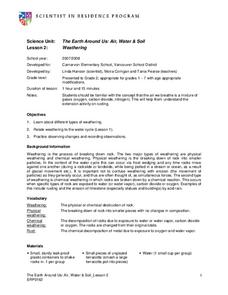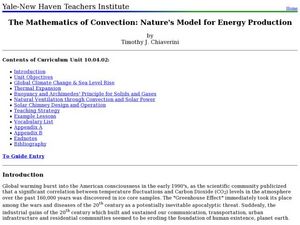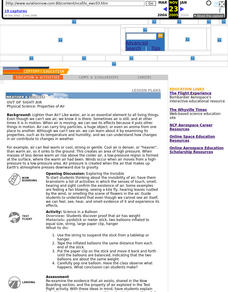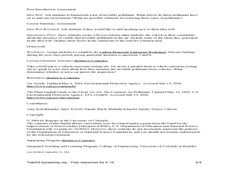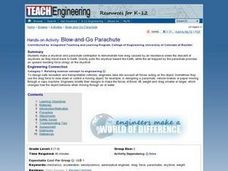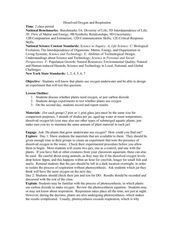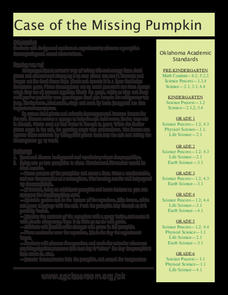Curated OER
How Do You Know There is Air in a Bag?
Fourth graders explore air as a material substance. Through experimentation and discussion, they explore how air can be classified as a material substance. Students write three examples proving that air is a material substance in their...
Nuffield Foundation
Measuring Rate of Water Uptake by a Plant Shoot Using a Potometer
How quickly does a plant transpire? Learners explore this question through measuring water uptake with a potometer. They time the movement of a bubble a set distance to understand the motion and rate of speed.
Curated OER
Weathering
Second graders explore weathering and how the water cycle plays a part in weathering. For this weathering lesson, 2nd graders put gravel and sugar cubes in a jar and shake, simulating weathering. Students use the scientific method...
Curated OER
Baking Ice Cream
Students discover the concept of an insulator. In this science experiment lesson, students follow the directions for baking ice cream. When baking is completed, students observe the results and answer questions on the provided worksheet.
Curated OER
The Mathematics of Convection: Nature's Model for Energy Production
High schoolers conduct a series of experiments to investigate density, buoyancy and climate. In this math activity, pupils design and build a hot air balloon to demonstrate convection. They research and write a paper about solar chimneys.
Curated OER
Out Of Sight Air; Weather
Fourth graders conduct an experiment to get them thinking about the invisibility of air, and to prove that air has weight.
Curated OER
Force of Air - Does Air do Work ?
Learners use a balloon, cardboard support, and wooden ping pong channel to complet an experiment to answer the question "Does Air do Work?" They complete a worksheet to demonstrate knowledge of the concept after the lab.
Curated OER
What is Air?
Students are introduced to the characteristics of air and where it can be found. As a class, they discover that no two objects can occupy the same space and discover how to calculate mass. In groups, they participate in an experiment...
Curated OER
The Rubber Band Air Test
Students complete an experiment to determine how dirty the air is in their local community. They analyze images and discuss the varying degrees of air pollution. They discuss the results of the experiment.
Curated OER
Air Pollution: Visible and Invisible
Fourth graders work together to complete an experiment on air pollution. They identify visible and invisible forms of pollution. They gather their data in notebooks and analyze their results to end the lesson plan.
Curated OER
The Science of Hurricanes
Students are introduced to the science of hurricanes in an effort to highlight how forces change the speed and direction of motion.
Curated OER
The Science of Hurricanes
Learners explore hurricanes. In this science lesson, students discuss the aspects of hurricanes and watch videos of hurricanes. Learners discuss the motion of the hurricanes.
Curated OER
Water and Ice
Young scholars participate in various air experiments to understand that air is all around us. In this states of matter lesson, students focus on the role of air in the water cycle. Young scholars understand that air is densest near the...
Curated OER
Bringing The Greenhouse Effect Down To Earth (CO2 experiment)
Learners compare 4 different form of carbon dioxide and discuss the role that carbon dioxide has in the Greenhouse Effect. They then understand that the Greenhouse Effect is a naturally occurring event.
Curated OER
A Sea Turtle Experience
Students observe live green sea turtles and use their imagination to form questions about the animals. They present these questions to their teacher. Students then complete the activity sheets highlighting sea turtle biology and...
Curated OER
The Physics of Toys
Students explore physics by experimenting with classic toys. In this physical science lesson, students utilize gliders, energy balls, bouncing balls, marbles and other toys to explore how they work. Students explore each toy at a work...
Curated OER
Is It Breathable?
Young scholars explore air quality. In this environmental lesson, students observe a simulation of air pollution by blowing into a jar (with a straw) that has chalk dust. Young scholars discuss how air quality can effect the way we breathe.
Curated OER
I Don't Believe My Eyes!
Young scholars develop their understanding of the effects of invisible air pollutants. In this invisible air lesson, students complete experiments with a rubber band air test, a bean plant experiment and by exploring engineering roles...
Curated OER
Blow-and-Go Parachute
Students design a skydiver and parachute constraption to demonstrate how drag caused by air resistance slows the descent of skydivers as they travel back to Earth. They experience how gravity pulls the skydiver toward the earth and how...
Curated OER
Dissolved Oxygen and Respiration
Students are presented with the question, "Do plants that grow underwater use oxygen?" They create an experiment to test the presence of dissolved oxygen in the water using provided materials. Student experiments include a control jar as...
Curated OER
Case of the Missing Pumpkin
Scientists define and discuss decomposition, and watch pumpkins decompose and return to soil in classroom experiment. They record the date the experiment began, chart changes in pumpkins on a calendar, count how many days it takes...
Curated OER
Simple Machines IV - Levers
The lever is an everyday simple machine. Youngsters learn the principles of levers and explore their many uses. Groups of pupils perform a simple lab where they lift objects with a fulcrum while placing the load in a variety of...
Curated OER
Exploring Electricity - Four Activities
These are four classic activities used for instructing upper elementary electricians. The first involves experimenting with the Van de Graaff generator. The second is a series of hands-on experiences with static. In the third activity,...
Kenan Fellows
Terrarium in a Bottle: Modeling the Atmosphere, Greenhouse Effect, and Water Cycle
You've heard of farm to table ... but what about farm in classroom? Junior agriculturalists embark upon a two-week journey into the science of growing things. Based upon the classic terrarium in a two-liter experiment, the lesson plan...


